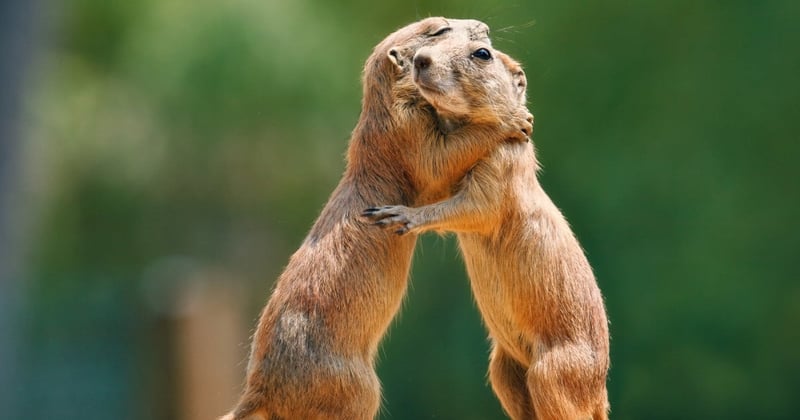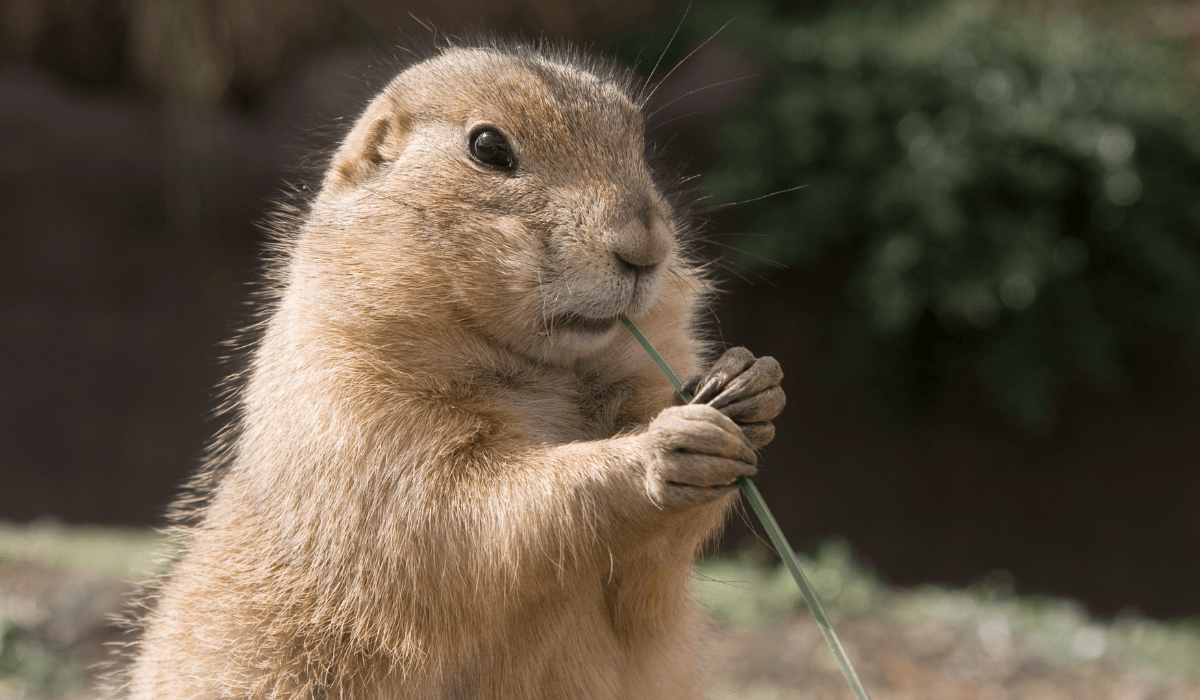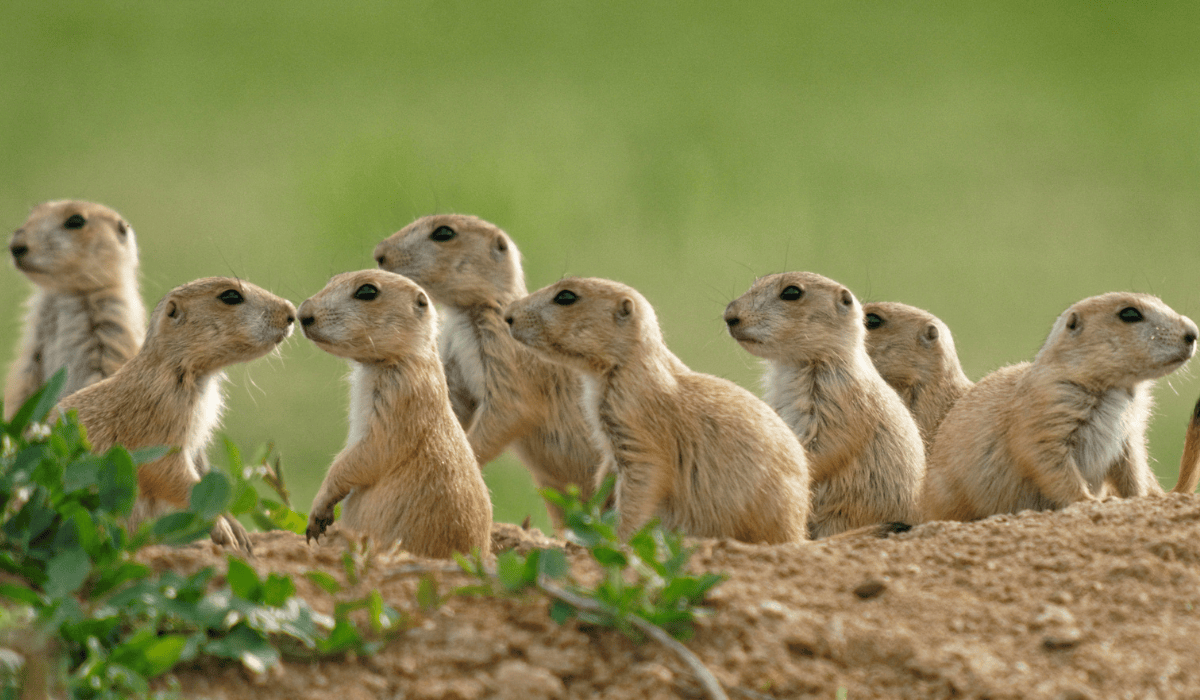
Learn everything about prairie dogs: what they eat, where they live, and why they should never be kept as pets.
When you think of the Great Plains, one tiny animal might not immediately come to mind, but prairie dogs are critical to the ecosystem and deserve our protection. Despite their name, prairie dogs aren’t dogs at all—they’re actually rodents—and while they may look cute and fuzzy, they are wild animals that should never be kept as pets.
Here’s everything you need to know about these fascinating (and controversial) animals and how we can protect them, not profit from them.
What Is a Prairie Dog?
A prairie dog is a burrowing rodent native to North America, primarily found in grassland ecosystems. They belong to the squirrel family (Sciuridae) and are closely related to ground squirrels, chipmunks, and marmots. With their short tails, full bodies, and sharp claws for digging, prairie dogs are uniquely adapted to life underground.
Despite being called “dogs,” their name actually comes from their high-pitched warning bark, which early European settlers thought sounded like a small dog. But don’t be fooled—they’re wild animals with complex behaviors, strong family bonds, and a crucial role in their habitats.
Where Do Prairie Dogs Live?
Prairie dogs primarily live across the western and central United States and Mexico. They are commonly found in shortgrass prairies and open plains where they can dig vast, interconnected tunnel systems known as “towns.” These underground homes can stretch for miles and house hundreds of prairie dogs in a single colony.
If you’re hoping to spot prairie dogs in the wild, head to national parks like Wind Cave National Park in South Dakota, Bryce Canyon in Utah, or the grasslands of New Mexico. Observing these animals in their natural environment is a respectful and responsible way to appreciate them.
What Do Prairie Dogs Eat?

Prairie dogs are herbivores and primarily eat grasses, roots, seeds, and occasionally flowers. Their diets help maintain healthy grasslands by trimming vegetation, allowing new growth, and keeping ecosystems in balance. In fact, many other animals—including bison and black-footed ferrets—rely on prairie dogs’ presence to survive.
Do Prairie Dogs Hibernate?
Prairie dogs don’t truly hibernate, but in colder regions, they enter a state of torpor—a lighter form of hibernation—where their body temperature drops, and they remain inactive in their burrows for extended periods. In warmer areas, they remain active throughout the year, even during winter.
How Long Do Prairie Dogs Live?
In the wild, male prairie dogs live to an average of five years while females usually live up to eight years. However, their lifespan can be cut short by habitat destruction, disease (like sylvatic plague), and human threats, including trapping, poisoning, and removal from their native homes.
Are Prairie Dogs Endangered?
While not all prairie dog species are endangered, some face serious threats. The Utah prairie dog and the Mexican prairie dog, for example, are listed as endangered by the IUCN Red List due to habitat loss and historical eradication campaigns.
Overall, prairie dog populations have plummeted due to urban development, agricultural expansion, and government-sanctioned poisoning programs. Yet these animals are considered a keystone species, meaning their presence supports an entire ecosystem of plants and animals. Without prairie dogs, hundreds of other species suffer.
Do Prairie Dogs Make Good Pets?
Absolutely not. Prairie dogs are wild animals with complex social needs, space requirements, and natural behaviors that cannot be met in captivity. Capturing them for the pet trade is cruel and causes intense stress for the animals. In captivity, they are often kept in solitary, small enclosures that deprive them of the opportunity to burrow, bond, and express their natural instincts.
Wild animals belong in the wild—not in people’s homes. Prairie dogs are not pets, and no matter how cute or curious they seem, keeping them captive is never ethical.
How to Get Rid of Prairie Dogs Without Harming Them
If prairie dogs have taken up residence on private property, there are humane, non-lethal options for coexistence or relocation. These methods include installing barriers, using visual deterrents, or contacting wildlife professionals who specialize in ethical wildlife management.
Killing or poisoning prairie dogs disrupts the ecosystem and can have long-term environmental consequences. Humane coexistence should always be the goal.
Meerkat vs. Prairie Dog: What’s the Difference?
While prairie dogs and meerkats share a few similarities—like living in groups and standing upright to keep watch—they are very different animals. Meerkats are native to Africa and belong to the mongoose family, whereas prairie dogs are North American rodents. Despite their visual similarities and behaviors, they are not closely related.
Why Prairie Dogs Matter

Prairie dogs are more than just adorable, squeaky burrowers. They are engineers of the grasslands, helping create homes for other animals, enriching the soil, and supporting biodiversity. Like so many wild animals, they are under threat from human activity, but with awareness and action, we can protect their futures.
By advocating for ethical wildlife tourism, avoiding wild pet ownership, and supporting organizations working to protect wild habitats, we can ensure prairie dogs stay right where they belong: wild and free on the prairie.
Want to protect animals like prairie dogs? Join World Animal Protection US’s FREE online community, Animal Champions, to take action today.